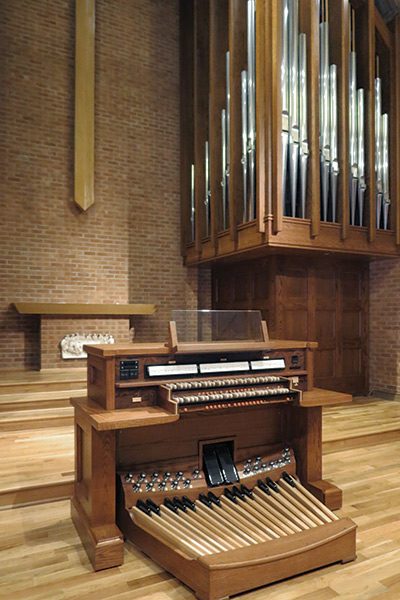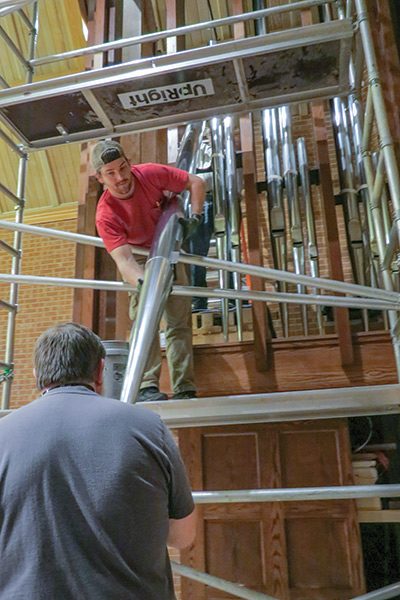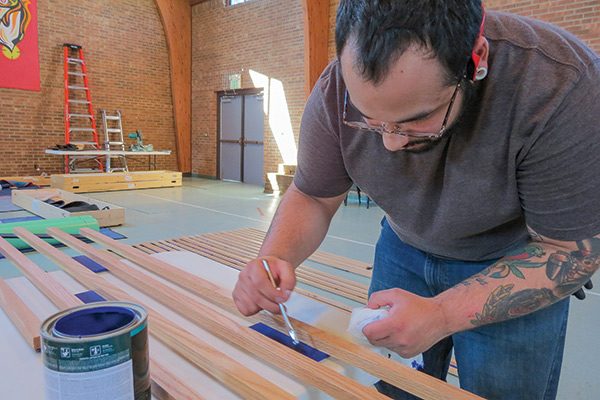Ebenezer Lutheran Church
Greensboro, NC
Parkey Organbuilders • Duluth, GA
By Phillip K. Parkey

My initial contact with Greensboro’s Ebenezer Lutheran Church occurred approximately five years ago, when William Carroll was the chair of the music department at the University of North Carolina, Greensboro, and the organist/choirmaster at Ebenezer Lutheran Church. We had met Dr. Carroll through our working relationships with other organists in Central North Carolina. The church had a “compiled” organ that had been installed in the 1980s and had never been successful. They began to explore options for replacing the organ completely. Dr. Carroll had previously been in the selection process with two other organs in the Greensboro area. Dr. Carroll had served as the choirmaster/organist previously at Ebenezer and was petitioned to return again based on his past success.
When we met for the first time, he was clear that Ebenezer had a strong music program and a strong singing congregation. The church’s needs called for a well-balanced service instrument. The committee was familiar not only with our recent installation at Providence United Methodist Church in Charlotte, North Carolina, but also one of our first instruments at a church in Salisbury. The committee visited several organs in and around Greensboro and decided that our work met the needs of their congregation. In addition, the committee resoundingly enjoyed the sound of our work.

After several discussions with the committee, we were asked to design an instrument for the front of the room. The Swell division of the old organ was housed in a side chamber that never allowed adequate tonal egress and was far too deep and ill-suited for the new installation. The cross and the altar were to remain the focal point of the room, and we were asked to carefully consider the logistics of Communion distribution to the congregation. The logical choice was a divided case installation. In this, our Opus 15, the Great and Pedal are housed in the left case, and the Swell is enclosed in the right case. The old Swell chamber was reduced to a depth of three feet, and the lowest eight notes of the 16′ Contra Bass were installed horizontally in the shallow space. Our designer worked with the committee to arrive at a simple but elegant case design that preserved the stately feel of the room.
Our tonal staff provided a principal chorus of a rich commanding presence. The organ offers a great dynamic range from the luscious strings in their expressive swell box to the full chorus with a broad, fiery Trompette and an Hautbois at 16′ and 8′.
The church could not have been more delightful to work with and we enjoyed a great deal of attention from the clergy and congregation during the installation. The organ was finished and dedicated with its first use on Easter Sunday. Tonal Director Fred Bahr carefully set the balances of the organ and the results are simply marvelous.
As a member church of the Missouri Synod, Ebenezer has a rich musical heritage that includes strong Lutheran hymn singing. While supporting hymn singing the organ also needed to provide accompaniment for contemplative moments such as prayer and Communion. Even on Easter Sunday, the church paid homage to its roots by opening services with Martin Luther’s robust hymn “A Mighty Fortress Is Our God.” Upon hearing the organ during its inaugural services, I believe that the organ provided the full range of expression equally well.

As a builder, I often find that the smaller projects can provide not only great challenges but also great rewards when completed. The goal of organbuilding is not to provide more ranks or stops or to build huge cases; rather, it is to provide an instrument that meets the needs of the client. It is truly a blessing to see the people of the church enjoy the rewards of their efforts.
We are grateful to the organ committee of Ebenezer Lutheran Church and to William Carroll for their patience and confidence in our firm to provide the new pipe organ for Ebenezer Lutheran Church.
Phillip Parkey is president of Parkey Organbuilders.
The Organbuilders
Phillip Parkey, Fredrick Bahr, Chris Bowman, John Elliano, Otilia Gamboa, Ben Lewis, Jonathan Meeks, Michael Morris, Johann Nix, Philip Read, Kurtis Robinson, Keith Williamson
From the Organist/Choirmaster
I have been associated with Ebenezer Lutheran Church off and on since 1985. The congregation sings lustily, the choir is capable, and the new Parkey organ is a most welcome addition. It has been my pleasure to be a part of three organbuilding projects during my career. Two of those projects were, for the most part, funded by a generous single donor. That was not the case at Ebenezer Lutheran. Over a lengthy period of time the congregation grappled with whether or not to move forward on an organbuilding project. Amazingly, some months ago in a congregational meeting a longtime member suggested, “Folks, it’s time we got this thing done.” Near unanimous consensus was found, an organ committee was appointed, and the project moved forward with the support of the clergy and the lay leadership. There was broad support and “buy in” for the project throughout the congregation. The lovely new instrument is a testament to the “togetherness” we all experienced in bringing this instrument to our church and community.
William P. Carroll
From the Designer
The evolution of the design for the organ was driven by a continual attention to balance. The service requirements for a church with an enviable tradition of lusty hymn singing required an instrument of a certain size. The location of the previous instrument had never been ideal. Parkey OrganBuilders decided to explore the options for putting an instrument on the front wall on either side of the chancel, and the congregation was open to this as long as we could give them enough room that Communion would not seem crowded. We had also noted that ribbed brick walls to the side of the altar—the only noticeable architectural ornament to the room—gave an increased sense of verticality to the space and would now be completely covered. We wanted a design that would continue to give the room a sense of loftiness. We also wanted it to meet what is always our first criterion—that the organ look as though it had always been there; that it gave a sense of belonging in the space. The church did not want a design that would seem too formal, and they wanted the central cross to remain a focus.
A variety of options were discussed, but the final design was a universal favorite, and the congregation voted unanimously to proceed.
Michael Morris
Opus 15’s Tonal Design
From a tonal designer’s vantage point, a church organ of 25 ranks always presents a unique set of challenges, opportunities, and temptations. One can eschew all unification and produce a very respectable instrument that will do the job: solid independent principal choruses for leading congregational singing, a pair of strings for Communion, a flute or two with matching bass for accompanying a small choir, and a smattering of reed and mutation tone for color.
Another approach is to embrace the concept of unification and use it to give the organist an almost limitless number of choices in registering the available tonal resources. Both avenues have distinct advantages and pitfalls in the very real world of church music making, and both avenues are of course crowded with successful proponents and detractors.
At Ebenezer, we chose a moderate route, strongly favoring the traditions of classical organbuilding, but not ignoring the needs of the organist either. The stop-list does not break any new ground, opting instead for a utility shaped by years of effective service playing. Octave unification is limited primarily to the Pedal division where its shortcomings are less obvious. The Swell strings and Trompete available independently on the Great manual allow some flexibility in registering them against other Swell stops.
Like many organs of this size, this instrument owes a large measure of its success to its sense of tonal balance. Each stop contributes its own essential component to the overall sound, without neglecting the role it plays with its neighbors in smaller combinations. No single stop is extraordinarily loud or whisper-soft. An efficient swell box, with thick walls and carefully fitted shades, increases the dynamic range. The unenclosed Great easily carries the room on its own. The “caged rage” sound of full Swell smolders behind it with the shades closed, then matches it as the shades open. At full organ the sound is thrilling without assaulting the listener.
Organbuilding is a matrix of complex systems. Physical and tonal design, funding, engineering, structure, construction, scaling, placement, and acoustics—each play a critical role in creating organ sound. But it is the people involved that turn craft into art, science into magic, sound into music, and expense into lasting legacy. It has been our privilege to work with each other and the people of Ebenezer Lutheran Church to create an instrument that we hope will bring joy to all who see, hear, and play it.
Fredrick Bahr, Tonal Director


